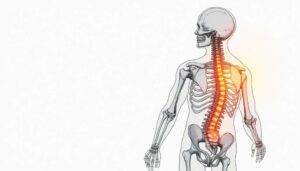Pain management is a critical part of living a healthy life. The two types of pain, acute and chronic, can have varying effects depending on their severity and duration. Acute pain involves a sudden onset that lasts for a brief period and is caused by an injury or illness. On the other hand, chronic pain can last for extended periods, often due to ongoing health issues such as spinal injuries.
Read more: Acute Pain VS Chronic Pain: What Should You Know.
The thoracic region of the spine is located in the middle back and helps to provide structural support. A wide range of symptoms can be associated with thoracic spinal pain, including localized discomfort, burning sensations, tightness, and tingling — ranging from mild to severe. Read on to understand more about the symptoms of thoracic spinal pain and how to manage them.
How Does Thoracic Pain Occur?
The spinal bones of the thoracic spine protect the spinal cord and support the body. However, when a person experiences an injury or condition that causes excessive pressure on these bones, it can lead to pain in this area, known as thoracic back pain. Conditions that can result in thoracic pain include herniated discs, spinal stenosis, osteoarthritis, poor posture, and fractures. In some cases, thoracic pain can be caused by the muscles surrounding the spine becoming tight or weak due to an injury or overuse.
Common Symptoms of Thoracic Pain
Thoracic back pain can range in intensity from mild to severe, but some common symptoms include:
1) Persistent aching or stiffness in the mid to upper back
The upper back is the most common area affected by thoracic back pain, which can be felt as persistent aching or stiffness. This can worsen with movement, such as bending or twisting the spine.
2) Muscle spasms
Muscle spasms in the upper to mid back are often a result of tightness in the muscles surrounding the spine. Spasms are typically experienced as sudden, sharp pains that can be very intense. The spasms may come and go in short bursts or become increasingly persistent. They may also radiate up the neck or back into the lower spine.
3) Loss of Range of Motion
Pain in the thoracic spine can decrease your range of motion or make it difficult for you to move freely. Activities such as twisting, leaning, and reaching can become uncomfortable or even unbearable. When this occurs, it’s essential to seek medical attention from a specialist who can diagnose the cause and provide treatments that can help relieve the pain and improve your range of motion.
4) Pain or Tingling in the Arms and Legs
Thoracic spine pain can also cause discomfort, numbness, or a burning sensation in the arms and legs. This is known as radicular pain and occurs when one of the thoracic nerve roots becomes compressed. Irritation of the nerve root can cause pain to radiate down the arm or leg. This pain may also accompany muscle weakness and difficulty controlling bowel or bladder function. If you are experiencing any of these symptoms, it is essential to seek medical attention as soon as possible.
Call APAC Centers for Pain Management for the best spinal pain treatment. Our Indiana pain management clinic is staffed with knowledgeable and experienced medical care professionals who can provide you with comprehensive pain management therapies.







